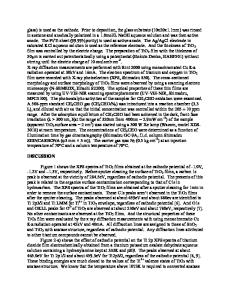Fabrication of two-dimensional photonic structure of titanium dioxide with sub-micrometer resolution by deep x-ray litho
- PDF / 2,976,959 Bytes
- 6 Pages / 612 x 792 pts (letter) Page_size
- 20 Downloads / 270 Views
R4.5.1
Fabrication of two-dimensional photonic structure of titanium dioxide with sub-micrometer resolution by deep x-ray lithography Koichi Awazu*1, Makoto Fujimaki1, Xiaomin Wang1, Akihide Sai2, Yoshimichi Ohki2 1 CAN-FOR, National Institute of Advanced Industrial Science and Technology (AIST), Tsukuba Central 4, 1-1-1 Higashi, Tsukuba 305-8562, Japan 2 Department of Electrical Engineering and Bioscience, Waseda University, 3-4-1 Ohkubo, Shinjuku-ku, Tokyo 169-8555, Japan *Author to whom correspondence should be addressed; electronic mail: [email protected] ABSTRACT Two dimensional photonic crystals of titanium dioxide is expected to have many advantage compared with photonic crystals of semiconductors, e.g., silicon and GaAs. For example, low optical loss in the near infrared region used for optical communication, low thermal expansion, and its refractive index which is close to that for optical fiber are attractive advantages. However, it is difficult to create micro-nano structure in titanium dioxide because micro-fabrication technique for semiconductor is not available for titanium dioxide. As the first step we calculated photonic band gap of titanium dioxide rod-slab on SiO2. Also, band gap percent against thickness of the rod-slab was examined. Finally, we confirmed the most suitable structure of 2D photonic crystals. Deep x-ray lithography technique was employed for create a very deep and precise template of PMMA. Then, liquid-phase deposition was used to faithfully deposit a tightly packed layer of titanium oxide onto the template. Finally, the template is selectively removed to obtain a photonic nano-structure. We also calculate photonic band gap on the 3D-structure of TiO2. A template for the most appropriate structure was fabricated by the method proposed by Yablonovitch. By using of the same method, it was successful to obtain 3D structure of TiO2. Refractive index of obtained TiO2 followed by heating at 700°C was determined to 2.5 which is close to that for anatase phase. INTRODUCTION Photonic crystals (PhCs) will comprise the building blocks of the photonic devices necessary for next-generation photonic networks. Especially, three dimensional photonic crystals stimulate our scientific concern because it is expected to provide full control of light spontaneous emission in all space directions. However, it is difficult to obtain three dimensional (3D) structures. Therefore, many researchers concern have concentrated on the fabrication of 2D-PhCs devices with micro-fabrication methods conventionally used for LSI process, such as reactive ion etching (RIE). For the next generation photonic network, PhCs devices are expected to be interesting alternatives for integrate optics. It has been possible to create the Yablonovite PCs or artificial opal PCs of PMMA (poly methylmethacrylate), yet the refractive index constant between PMMA and air is insufficient to obtain a complete photonic gap. It should be needed to remove template material after the pores are filled with high refractive index material.
R4.
Data Loading...











